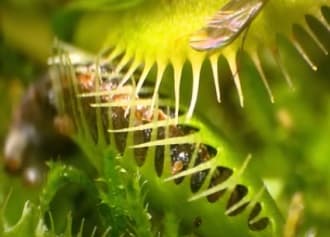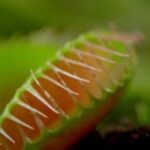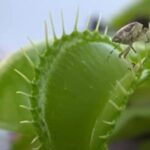As an Amazon Associate, this site earns commissions from qualifying purchases. For more details, click here.
The allure of Venus flytraps (Dionaea muscipula) extends beyond their carnivorous nature, captivating enthusiasts with their unique appearance and captivating behavior. While Venus flytraps can thrive in solitary conditions, companion planting offers an opportunity to enhance their environment, promote biodiversity, and create visually stunning displays
Key Takeaways:
- Venus flytraps thrive in the company of a diverse range of companion plants, including sundews, pitcher plants, butterworts, sphagnum moss, and carnivorous bromeliads.
- Successful companion planting with Venus flytraps relies on selecting species that share similar soil and light requirements. Acidic, nutrient-poor soil and ample sunlight are key factors that contribute to the health and vitality of both Venus flytraps and their companions.
- Incorporating companion plants into Venus flytrap gardens promotes ecological balance by attracting a diverse array of insects ,
Sundews (Drosera spp.)
Sundews, members of the Drosera genus, are carnivorous plants renowned for their glistening, dew-covered tentacles that lure and ensnare unsuspecting insects. These botanical marvels make ideal companions for Venus flytraps, as they share similar growing conditions and prey-capturing mechanisms.
Sundews thrive in acidic, nutrient-poor soil and require ample sunlight, making them well-suited for cohabitation with Venus flytraps. Popular species such as Drosera capensis and Drosera spatulata offer a striking contrast to the Venus flytrap’s iconic traps, creating a visually captivating ensemble that intrigues and educates observers.
Pitcher Plants (Sarracenia spp.)
Pitcher plants, belonging to the Sarracenia genus, are renowned for their elegant, trumpet-shaped leaves that act as pitfall traps for unsuspecting insects. Like Venus flytraps, pitcher plants are native to nutrient-poor habitats and thrive in acidic, well-draining soil. You can also grow them indoors.
By incorporating pitcher plants into a Venus flytrap garden, enthusiasts can create a harmonious ecosystem that attracts a diverse array of insects while fostering mutualistic interactions between these carnivorous species. Whether it’s the vibrant hues of Sarracenia purpurea or the intricate patterns of Sarracenia flava, pitcher plants add a touch of elegance and intrigue to any carnivorous plant collection.
Butterworts (Pinguicula spp.)
Butterworts, members of the Pinguicula genus, are diminutive carnivorous plants characterized by their rosettes of succulent leaves adorned with sticky glandular hairs. These botanical gems excel in moist, well-draining soil and partial sunlight, making them compatible companions for Venus flytraps.
Butterworts capture and digest small insects using their adhesive leaves, complementing the predatory prowess of Venus flytraps while adding diversity to the carnivorous plant collection. Whether it’s the delicate blooms of Pinguicula moranensis or the compact foliage of Pinguicula cyclosecta, butterworts offer a charming addition to any Venus flytrap garden.
Sphagnum Moss
Sphagnum moss, also known as peat moss, serves as a versatile companion plant for Venus flytraps, providing both aesthetic and practical benefits. This moisture-retaining moss creates a conducive microclimate around the base of Venus flytrap pots, helping regulate soil moisture levels and maintain acidic conditions.
Additionally, sphagnum moss acts as a natural insulator, protecting the delicate roots of Venus flytraps from temperature fluctuations and providing a lush backdrop for their captivating traps. Whether used as a top dressing or integrated into planting media, sphagnum moss enhances the overall health and vitality of Venus flytrap gardens.
Carnivorous Bromeliads (Brocchinia spp.)
Carnivorous bromeliads, such as Brocchinia reducta, offer a tropical twist to Venus flytrap gardens, showcasing the diversity of carnivorous plants from around the world. These epiphytic bromeliads feature rosettes of leaves that form water-filled pitchers capable of trapping and digesting insects.
While carnivorous bromeliads have slightly different care requirements compared to Venus flytraps, they can coexist harmoniously in a moist, well-lit environment, creating a captivating display of botanical diversity. Whether it’s the cascading foliage of Brocchinia hechtioides or the architectural elegance of Brocchinia tatei, carnivorous bromeliads add a touch of exotic allure to any carnivorous plant collection.
You can also grow multiple Venus flytraps together, but keep in mind the legalities involved if you want to harvest them.
Other Plants That Grow Well with Venus Flytraps
In addition to the carnivorous companion plants mentioned earlier, several non-carnivorous plants and flowers can thrive alongside Venus flytraps, enhancing the overall aesthetics and biodiversity of the garden. Here are some examples:
Mosses and Ferns
Non-carnivorous mosses and ferns can create a lush, verdant backdrop for Venus flytraps while thriving in similar soil and light conditions. Species such as sphagnum moss, ferns like maidenhair ferns (Adiantum spp.), and mosses like cushion moss (Leucobryum glaucum) add texture and visual interest to the garden while helping to retain moisture and maintain soil acidity.
Orchids
Certain species of orchids, particularly those that prefer acidic growing conditions, can coexist harmoniously with Venus flytraps. Epiphytic orchids like miniature Phalaenopsis or jewel orchids (Ludisia discolor) add elegance and color to the garden, complementing the striking appearance of Venus flytrap traps with their delicate blooms and foliage.
Bulbs and Perennials
Select bulbs and perennials that thrive in acidic, well-draining soil can thrive alongside Venus flytraps, adding seasonal interest and variety to the garden. Examples include woodland bulbs like trilliums, snowdrops, and crocuses, as well as perennials like astilbes, fern-leaf bleeding hearts (Dicentra spp.), and hostas.
Native Wildflowers
Incorporating native wildflowers into a Venus flytrap garden not only adds color and beauty but also supports local pollinators and wildlife. Choose native species that are adapted to the growing conditions of your region, such as bee balm (Monarda spp.), coneflowers (Echinacea spp.), black-eyed Susans (Rudbeckia spp.), and goldenrods (Solidago spp.).
Ground Covers
Low-growing ground covers help suppress weeds, retain soil moisture, and create a cohesive look in a Venus flytrap garden. Select varieties that tolerate acidic soil and partial shade, such as creeping thyme, creeping Jenny (Lysimachia nummularia), or mossy saxifrage (Saxifraga x arendsii).
When selecting companion plants for Venus flytraps, it’s essential to consider their compatibility with the growing conditions of your garden, including soil pH, moisture levels, and sunlight exposure. By choosing plants that share similar requirements and complement the unique characteristics of Venus flytraps, you can create a harmonious and visually appealing garden that delights both the eye and the imagination.
Will Venus Flytraps Harm Non-Carnivorous Plants?
Carnivorous plants, including Venus flytraps and other species like sundews, pitcher plants, and butterworts, are not inherently harmful to non-carnivorous plants. However, there are a few considerations to keep in mind when growing carnivorous plants alongside non-carnivorous ones:

Competitive Root Systems
Some carnivorous plants, especially those with extensive root systems like pitcher plants, may compete with neighboring non-carnivorous plants for nutrients and water in the soil. It’s essential to provide adequate space and ensure proper drainage to prevent root competition and maintain the health of all plants in the garden.
Trapping Mechanisms
While carnivorous plants primarily prey on insects and small invertebrates, they may occasionally trap and digest small organisms like springtails, which are beneficial decomposers found in the soil. However, this is typically not harmful to non-carnivorous plants, as the impact on soil ecology is minimal.
Light Requirements
Many carnivorous plants, including Venus flytraps and sundews, require ample sunlight to thrive. When planting them alongside non-carnivorous plants, consider the light requirements of both species to ensure that each receives adequate sunlight without shading or overcrowding.
Soil Acidity
Carnivorous plants typically prefer acidic, nutrient-poor soil, which may not be suitable for all non-carnivorous plants. While some non-carnivorous species, such as certain orchids and ferns, tolerate acidic conditions, others may prefer neutral or alkaline soil. It’s essential to select companion plants that are compatible with the soil pH preferences of carnivorous plants to avoid nutrient deficiencies or other issues.
Overall, with proper planning and care, carnivorous plants can coexist harmoniously with non-carnivorous plants in a garden setting. By selecting companion plants that share similar growing conditions and considering factors such as root competition, trapping mechanisms, light requirements, and soil acidity, you can create a diverse and thriving ecosystem that benefits all plants involved.
Do Venus Flytraps Grow in Bog Gardens?
Venus flytraps can thrive in bog gardens. In fact, bog gardens are an ideal environment for Venus flytraps because they mimic their natural habitat. Venus flytraps are native to the boggy areas of the southeastern United States, where they grow in acidic, nutrient-poor soil that is consistently moist or even waterlogged.
Bog gardens typically consist of a water-retentive soil mix, such as a combination of peat moss and perlite or sand, which helps maintain moisture levels while allowing for proper drainage. The acidic conditions of bog gardens also provide an ideal growing environment for Venus flytraps, as they prefer soil with a pH level between 4 and 5.
When establishing a bog garden for Venus flytraps, it’s essential to mimic the natural conditions of their native habitat as closely as possible. This includes providing ample sunlight, as Venus flytraps require full sun to thrive. Additionally, maintaining high humidity levels and avoiding fertilizers or tap water with high mineral content will help ensure the health and vitality of Venus flytraps in a bog garden setting.
Overall, bog gardens offer an excellent opportunity to create a thriving habitat for Venus flytraps and other carnivorous plants, allowing enthusiasts to enjoy these fascinating plants while supporting their natural growth and development.
Conclusion
Companion planting offers a myriad of benefits for Venus flytrap enthusiasts, from enhancing the beauty of the garden to promoting ecological balance and providing additional insect control. By selecting companion plants that share similar soil and light requirements, such as sundews, pitcher plants, butterworts, sphagnum moss, and carnivorous bromeliads, enthusiasts can create thriving ecosystems that support the health and vitality of their Venus flytraps.
Experimenting with different combinations of companion plants allows enthusiasts to discover the perfect symbiotic relationship for their Venus flytrap garden, fostering a deeper appreciation for these captivating carnivorous plants and the intricate web of life they support.

My fascination with carnivorous plants began many, many years ago with Venus Fly Traps. Now I am more than happy to impart what I know with other enthusiasts and those who are curious about meat eating plants.


